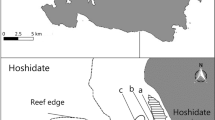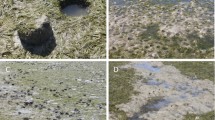Abstract
Structural equivalence between seagrass restoration sites and adjacent natural seagrass beds on the mid Texas coast was assessed six times between April 1995 and May 1997. Throw traps and corers were used for quantitative sampling. Restoration sites were 2.7 to 6.6 yr old when first sampled and 3.7 to 8.2 yr old when last sampled. There were few significant differences in water column, seagrass, or sediment characteristics, in fish and decapod (nekton) densities, or in nekton and benthos community compositions between restored and natural seagrass habitats at any time during the study period. Differences in densities of dominant benthic invertebrates were regularly observed, with greater densities of more taxa observed in natural seagrasses than in restored beds. Densities of Class Oligochaeta and the polychaetePrionospio heterobranchiata are proposed as potential indicators of structural equivalence in restored seagrasses. This study indicates that seagrass restorations in the vicinity of Corpus Christi, Texas, exhibit minimal quantitative differences in community structure (except for benthos) relative to adjacent natural seagrass beds after 3 to 5 yr.
Similar content being viewed by others
Literature Cited
Altsman, D., R. DeMay, andL. Handley. 2004. Gulf of Mexico seagrass status and trends. Scientific Investigations Report. U.S. Geological Survey, Lafayette, Louisiana and U.S. Environmental Protection Agency, Gulf of Mexico Program Office, Stennis Space Center, Mississippi.
Bell, S. S., L. A. J. Clements, andJ. Kurdziel. 1993. Production in natural and restored seagrasses: A case study of a macrobenthic polychaete.Ecological Applications 3:610–621.
Brown-Peterson, N. J., M. S. Peterson, D. A. Rydene, andR. W. Eames. 1993. Fish assemblages in natural versus well-established recolonized seagrass meadows.Estuaries 16:177–189.
Carr, M. H., andM. A. Hixon. 1997. Artificial reefs: The importance of comparisons with natural reefs.Fisheries 22:28–33.
Clarke, K. R. 1993. Non-parametric multivariate analyses of changes in community structure.Australian Journal of Ecology 18:117–143.
Clarke, K. R., andR. H. Green. 1988. Statistical design and analysis for a “biological effects” study.Marine Ecology Progress Series 46:213–226.
Dean, W. E. 1974. Determination of carbonate and organic matter in calcareous sediments and sedimentary rocks by loss on ignition: Comparison with other methods.Journal of Sedimentary Petrology 44:242–248.
Duke, T. andW. L. Kruczynski. 1992. Status and trends of emergent and submerged vegetated habitats, Gulf of Mexico, U.S.A. U.S. Environmental Protection Agency, EPA-800-R-92-003, Stennis Space Center, Mississippi.
Dunton, K. H. 1990. Production ecology ofRuppia maritima L. s. l. andHalodule wrightii Aschers, in two subtropical estuaries.Journal of Experimental Marine Biology and Ecology 143:147–164.
Dunton, K. H. 1994. Seasonal growth and biomass of the subtropical seagrassHalodule wrightii in relation to continuous measurements of underwater irradiance.Marine Biology 120: 479–489.
Dunton, K. H. andD. A. Tomasko. 1994. In situ photosynthesis in the seagrassHalodule wrightii in a hypersaline subtropical lagoon.Marine Ecology Progress Series 107:281–293.
Folk, R. L. 1980. Petrology of Sedimentary Rocks. Hemphill Publishing Company, Austin, Texas.
Fonseca, M. S. 1992. Restoring seagrass systems in the United States, p. 79–110.In G. W. Thayer (ed.), Restoring the Nation’s Marine Environment. UM-SG-TS-92-06. Maryland Sea Grant Publication, College Park, Maryland.
Fonseca, M. S., B. E. Julius, andW. J. Kenworthy. 2000. Integrating biology and economics in seagrass restoration: How much is enough and why?Ecological Engineering 15:227–237.
Fonseca, M. S., W. J. Kenworthy, D. R. Colby, K. A. Rittmaster, andG. W. Thayer. 1990. Comparisons of fauna among natural and transplanted eelgrassZostera marina meadows: Criteria for mitigation.Marine Ecology Progress Series 65:251–264.
Fonseca, M. S., W. J. Kenworthy, andF. X. Courtney. 1996a. Development of planted seagrass beds in Tampa Bay, Florida, U.S.A. I. Plant components.Marine Ecology Progress Series 132: 127–139.
Fonseca, M. S., D. L. Meyer, andM. O. Hall. 1996b. Development of planted seagrass beds in Tampa Bay, Florida, U.S.A. II. Faunal components.Marine Ecology Progress Series 132:141–156.
Fonseca, M. S., W. J. Kenworthy, and G. Thayer. 1998. Guidelines for the conservation and restoration of seagrasses in the United States and adjacent waters. U.S. Department of Commerce, National Oceanic and Atmospheric Administration, NOAA Coastal Ocean Program Decision Analysis Series No. 12, Silver Spring, Maryland.
Hair, C. A., J. D. Bell, andM. J. Kingsford. 1994. Effects of position in the water column, vertical movement and shade on settlement of fish to artificial habitats.Bulletin of Marine Science 55:434–444.
Harper, Jr.D. E. 1992. Characterization of open bay benthic assemblages of the Galveston Estuary and adjacent estuaries from the Sabine River to San Antonio Bay, p. 414–439.In C. Loeffler and A. Walton (eds.), Status and Trends of Selected Living Resources in the Galveston Bay System. GBNEP-19. Galveston Bay National Estuary Program, Houston, Texas.
Heck, Jr.K. L., C. Hays, andR. J. Orth. 2003. Critical evaluation of the nursery role hypothesis for seagrass meadows.Marine Ecology Progress Series 253:123–136.
Hellier, Jr.,T. R. 1962. Fish production and biomass studies in relation to photosynthesis in the Laguna Madre of Texas.Publications of the Institute of Marine Sciences, University of Texas 8:1–22.
Hoese, H. D. andR. S. Jones. 1963. Seasonality of larger animals in a Texas turtle grass community.Publications of the Institute of Marine Sciences, University of Texas 9:37–47.
Kirkman, H. 1992. Large-scale restoration of seagrass meadows, p. 111–140.In G. W. Thayer (ed.), Restoring the Nation’s Marine Environment. UM-SG-TS-92-06. Maryland Sea Grant Publication, College Park, Maryland.
Kushlan, J. A. 1981. Sampling characteristics of enclosure fish traps.Transactions of the American Fisheries Society 110:557–562.
Levin, L. A., D. Talley, andG. Thayer. 1996. Succession of macrobenthos in a created salt marsh.Marine Ecology Progress Series 141:67–82.
Lewis, III,R. R. 1989. Wetlands restoration/creation/enhancement terminology: Suggestions for standardization, p. 1–7.In J. A. Kusler and M. E. Kentula (eds.), Wetland Creation and Restoration: The Status of the Science. Volume II: Perspectives. EPA 600/3-89/038b. U.S. Environmental Protection Agency, Corvallis, Oregon.
Montagna, P. A. andR. D. Kalke. 1992. The effect of freshwater inflow on meiofaunal and macrofaunal populations in the Guadulupe and Nueces estuaries, Texas.Estuaries 15:307–326.
Odum, E. P. 1972. Ecosystem theory in relation to man, p. 11–24.In J. A. Weins (ed.), Ecosystem Structure and Function. Oregon State University Press, Corvallis, Oregon.
Orth, R. J. andJ. van Montfrans. 1990. Utilization of marsh and seagrass habitats by early stages ofCallinectes sapidus: A latitudinal perspective.Bulletin of Marine Science 46:126–144.
Pacific Estuarine Research Laboratory. 1990. A manual for assessing restored and natural coastal wetlands with examples from southern California. T-CSGCP-021. California Sea Grant Publication, La Jolla, California.
Pulich, Jr.W. M. 1982. Edaphic factors related to shoalgrass (Halodule wrightii Aschers.) production.Botanica Marina 25: 467–475.
Rountree, R. A. 1989. Association of fishes with fish aggregation devices: Effects of structure size on fish abundance.Bulletin of Marine Science 44:960–972.
Rountree, R. A. 1990. Community structure of fishes attracted to shallow water fish aggregation devices off South Carolina, U.S.A.Environmental Biology of Fishes 29:241–262.
Sheridan, P. 2004. Recovery of floral and faunal communities after placement of dredged material on seagrasses in Laguna Madre, TexasEstuarine Coastal and Shelf Science 59:441–458.
Sheridan, P., C. Henderson, andG. McMahan. 2003. Fauna of natural seagrass and transplantedHalodule wrightü (shoalgrass) beds in Galveston Bay, Texas.Restoration Ecology 11:139–154.
Short, F. T., D. M. Burdick, C. A. Short, R. C. Davis, andP. A. Morgan. 2000. Developing success criteria for restored eelgrass, salt marsh, and mud flat habitats.Ecological Engineering 15:239–252.
Short, F. T., andS. Wyllie-Echeverria. 1996. Natural and human-induced disturbance of seagrasses.Environmental Conservation 23:17–27.
Simmons, E. G. 1957. A ecological survey of the upper Laguna Madre of Texas,Publications of the Institute of Marine Sciences, University of Texas 4:156–200.
Stokes, G. M. 1974. The distribution and abundance of penaeid shrimp in the lower Laguna Madre of Texas, with a description of the live bait fishery. Texas Parks and Wildlife Department, Technical Series 15. Austin, Texas.
Tunnell, Jr.,J. W., Q. R. Dokken, E. H. Smith, andK. Withers. 1996. Current status and historical trends of the estuarine living resources within the Corpus Christi Bay National Estuary Program study area. Volume 1. CCBNEP-06A. Texas Natural Resources Conservation Commission, Austin, Texas.
Author information
Authors and Affiliations
Rights and permissions
About this article
Cite this article
Sheridan, P. Comparison of restored and natural seagrass beds near Corpus Christi, Texas. Estuaries 27, 781–792 (2004). https://doi.org/10.1007/BF02912040
Received:
Revised:
Accepted:
Issue Date:
DOI: https://doi.org/10.1007/BF02912040




